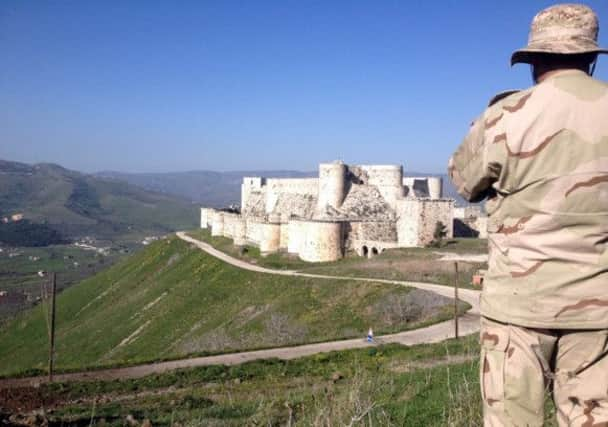Crusader castle the latest victim of Syria war


The world’s best preserved medieval Crusader castle, perched on a hilltop in western Syria, has fallen victim to the chaos of the country’s civil war as rebels fight to topple president Bashar al-Assad. The damage done to the Unesco World Heritage site shows that the warring sides will stop at nothing, including the destruction of the country’s rich heritage, to hold on to power or territory.
The Crac des Chevaliers, 25 miles west of Homs and just north of the Lebanese border, caught the eye of a young TE Lawrence, who called it one of the world’s greatest castles. It dominates the surrounding hills and valleys and was one of the crown jewels of Syrian tourism before the conflict began.
Advertisement
Hide AdAdvertisement
Hide AdLike many of the country’s most significant historical sites, Crac des Chevaliers has been literally caught in the crossfire in a conflict that activists say has killed more than 150,000 people.
Some sites have been turned into military bases. Shelling has smashed historic mosques, churches and markets. Looters have stolen artefacts from archaeological sites and museums.
About two years ago, Mr Assad’s forces identified the Sunni village of Hosn below the castle as rebel supporters. They began an armed blockade, saying Hosn harboured foreign, al-Qaeda-linked armed insurgents who terrorised neighbouring, mostly Christian villages.
“The terrorists killed and kidnapped people and even chopped off their heads,” said a Syrian army officer, using the regime’s term for insurgents. “We had to stop them at any cost.”
Throughout the war, the Assad regime has employed armed siege tactics to devastating effect: shelling and starving fighters and civilians alike in opposition-held areas into submission or flight.
Under heavy bombardment last winter, Hosn’s population of around 9,000 people had few places to go but up the hill to the castle, and hundreds barricaded themselves inside.
Among them were dozens of rebel fighters who occasionally lobbed mortar shells from inside the walls, hitting nearby Christian villages, according to government soldiers and locals.
The insurgents are overwhelmingly from the country’s Sunni majority. Shiite Muslims and Christian minorities have either remained neutral or supported Mr Assad.
Advertisement
Hide AdAdvertisement
Hide AdThose who found shelter inside the citadel ate the little food they had taken with them, or sneaked out at night to search for anything that could be cooked, including cats and dogs. For seven months, they slept in the tiny church inside the walled compound, or in huge stone halls used as stables by the Crusaders in the 12th century.
The villagers apparently hoped that castle’s thick walls – and its historic importance – would prevent the Syrian army from further shelling. It didn’t.
In March, during a massive government offensive against opposition strongholds on the Lebanese border, jets unleashed a series of airstrikes. Heavy cannon fire pummelled the castle walls, with shells causing some of the ancient stone structures to crumble.
The army did not stop there. Its tanks went house to house in the empty village, methodically destroying each one. About 300 villagers and rebels were killed in the offensive and hundreds more were wounded.
Several thousand villagers managed to flee to Lebanon, according to government figures. Hundreds surrendered or were captured.
“A lot of people have been killed by the terrorists,” said Rami Sarheed, 23, a Christian from the nearby village of Nasra. The government offensive “had to be done so that Syria returns to normal”, he said.
But there is little normality to be seen in this now ghostly village, where two Syrian army tanks flying government flags stand guard on the main road.